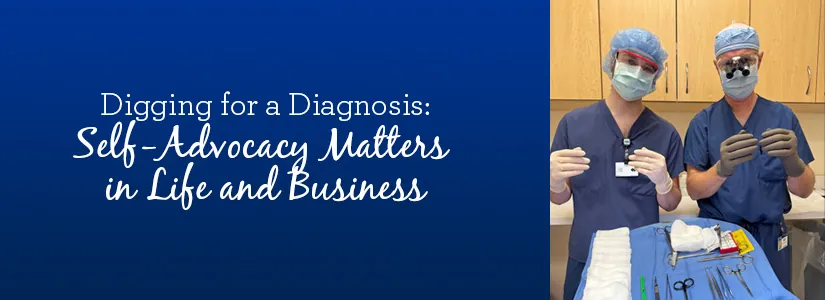
Last summer I started having issues with my thumb. It came out of nowhere, without an apparent cause. As July turned to August, my mild symptoms worsened to pain, clicking, and locking of my thumb joint.
I called my physician to share the situation and let him know I was coming in for a physical in September. He immediately replied, “I am ordering x-rays for both hands; please have them taken before you come in.” I compiled, and my thumb got progressively worse with each passing week.
By my mid-September physical, it had become difficult to actually do certain tasks. In addition to my previous symptoms, I lost range of motion in my thumb. My physician, whom I’ve seen for a long-time, trust immensely and has always demonstrated care and interest in my health, reported: “From the x-rays, I truly believe you have standard degeneration in your hands for your age. I don’t see any arthritis or other conditions that could be causing your difficulty.”
I left the office in utter disbelief. If my physician was correct and this was “natural aging,” I knew I didn’t like the aging process. During the next six weeks, my thumb worsened. So I decided to engage a close personal physician friend for a second opinion with my x-ray information in hand. After examining my hand and finger, he said, “I don’t really see anything wrong, possibly a bit of tendonitis.”
My obvious question: What can I do to fix this? He recommended avoiding moving the tendon for two to three days. Use an ice pack on the tendon for 20 minutes every two to three hours. Support the tendon with a soft brace. By now I was unable to tie my shoe, hold a cup, open a jar, button my clothes, and more daily tasks.
I followed the advice for two weeks with no relief. I turned now to another neighbor and friend, a nurse anesthetist at an orthopedic medicine clinic. I shared my saga and asked for

a referral to a hand specialist. My friend told me he could help me navigate the system and get me in quickly, so I gratefully accepted the offer. Within a week, the hand specialist examined my
hand for less than ten minutes and reported that I had stenosing tenosynovitis. Best of all, a simple surgical procedure could undo the damage, eliminate pain, and restore my range of motion.
Two short weeks later, the procedure was behind me and healing in front of me. Several months post-surgery, and all is well.
Unbeknownst to me until I met with a hand surgeon, I did not understand how my condition could be so challenging to diagnosis. I learned the symptoms I was experiencing can overlap with other conditions such as arthritis, tendonitis, and nerve compression. I was grateful I kept digging deeper.
My story is a microcosm of what can happen to any of us. If you feel like you are not being heard (or advice isn’t working), you need to advocate for yourself. Granted, it’s easier said than done considering how our myriad of other priorities can distract us from persisting.
Advocating in either personal or professional moments takes tenacity and patience and can be a powerful tool for success. Creating a culture of advocacy in which stakeholders feel heard and their ideas are respected fosters a greater sense of loyalty and commitment among stakeholders (employees, clients, and others).
Five steps for successful advocating
- Clarity
- Clearly define your objectives and desired outcomes. Since it can be difficult to figure out exactly what you want or how to get the conversation started, well-defined goals help you stay focused and develop a strategic plan for achieving them.
- Ensure what you are advocating for aligns with company strategic objectives and
values. The desired outcome needs to benefit you personally and a larger group
(colleagues, clients, partners). Start with a sense of the end in mind. - Approach your advocacy with empathy, emotional intelligence, and sensitivity to
what others might be facing.
- Gathering Data
- Once you know what end you are working to achieve, gather relevant qualitative and quantitative data to support your advocacy initiative. Ensure that your advocacy is ground in solid data and factual evidence:
- Understand the issue.
- How is the issue affecting you?
- How is the issue affecting others?
- Who can help you?
- Once you know what end you are working to achieve, gather relevant qualitative and quantitative data to support your advocacy initiative. Ensure that your advocacy is ground in solid data and factual evidence:
- Initiating
With clarity and data, you are ready to dig in:- Develop communication with a tailored message to the audience. Ensure you have compelling narratives with relatable examples.
- Seek out others who might have similar vision or feeling and an interest in advocating with you as they see a benefit for a larger group. Presenting as a united front strengthens credibility and amplifies your voice.
- Be open to feedback. Advocating often involves give-and-take and compromise on all fronts. Look for opportunities to find common ground and address others’ concerns and perspectives while still advancing your issue, even if a bit modified.
- Navigating
Advocating can take time. In the process, it’s important to:- Stay organized and maintain documentation related to your advocacy effort. This will help you track progress and identify patterns.
- Remain persistent and resilient. You will likely experience a long process that includes setbacks and obstacles along the way.
- If you consistently face significant internal resistance or lack of buy-in from key stakeholders, be sure you are using active listening skills to understand their perspective and ask curious questions to learn more.
- There are times it is important to reevaluate the issue and your approach. Consider adapting your approach or other alternatives.
- Practice patience and perseverance.
- Celebrate small victories.
- Monitoring progress
Implement these steps in your advocacy strategy and you can position yourself as a collaborative, solution-based advocate seeking to bring people together around shared goals. It’s always important to measure impact and regularly evaluate the measurable impact of your advocacy efforts and the return on your investment.
If you’re developing a culture of advocacy where all voices are heard and you’re looking for a partner to help you strategically, let’s start a conversation. Call 800-742-6800 or email today. For more information and tips for engaging stakeholders, sign up for our monthly newsletter. You can find our newsletter sign-up at Askhillarys.com at the bottom right corner of the page.
